Ground Deformation Associated with Deep Excavations in Beijing, China
Abstract
:1. Introduction
2. Typical Details concerning Deep Excavation
2.1. Geotechnical and Geological Conditions
2.2. Excavation Method
2.3. Support System
2.4. Database of Cases
3. Characteristic Analysis of Deformation
3.1. Analysis of Final Surface Deformation
3.2. Deformation Development
3.3. Factors Influencing Maximum Surface Deformation
3.3.1. Excavation Depth
3.3.2. Length–Width Ratio
3.3.3. Embedded Depth Ratio
3.3.4. Support System Stiffness
3.4. Deformation Model
4. Discussion
5. Conclusions
- Long strip pits are susceptible to considerable deformation, which increases with the length–width ratio. The typical range of surface deformations that occur due to deep excavations is between 0 and −30 mm, accounting for approximately 83.9% of the total. Only 8% of measurement points exhibited settlements with values greater than −30 mm. Points indicative of upheaval represent 8.1% of the points. Deep excavations can lead to both surface settlement and ground upheaval. Minor upheavals were observed within a range of 5 m from the edge corners, which decreased in accordance with increased excavation levels, and they featured a few final data points.
- Maximum ground surface settlements are influenced by workmanship, they increase in accordance with the excavation depth, and they decrease as the embedded depth ratio (EDR) increases. The average values for these are 0.089%H (typically under 30 mm) and 0.36, respectively. Settlements are affected both by ground conditions and support system stiffness, and they reduce in size as stiffness increases. However, an increase of 0.6 ± 0.4 mm~2.8 ± 0.75 mm occurred during the demolition of 1–2 struts above the base plate. The additional stress from this demolition was the result of substantial soil stress and a smaller internal structure stiffness. Unlike some studies in the literature, the maximum surface settlement was found to not always occur during excavations to the bottom level. It is suggested that temporary reinforcements should be utilized in deep and large excavations as to minimize distortion.
- The deformation exhibits clear temporal and spatial effects. Each point’s settlement rate gradually increases with the progression of the excavation level over time, particularly at the start of drainage consolidation. However, once the internal structure is operating, the deformation tends to stabilize. Each wall tends to exhibit a depression behind it, with maximum deformations occurring in the middle of its long edge. Deformation is comparatively lower along the shorter side, and it reaches its minimum at the corners where stiffness is increased due to the additional constraints of the oil and support structures.
- The “groove” patterns of the surface deformations are detected in excavations which have sufficient stiffness in Beijing, which are located at a distance of 0.5H–0.75H from the wall. The influence zones generally extend up to a maximum distance of 25–40 m (≤2.5–3H) from the excavation site, with few deformations occurring further than 25 m away the wall.
Author Contributions
Funding
Institutional Review Board Statement
Informed Consent Statement
Data Availability Statement
Conflicts of Interest
References
- Wang, J.H.; Xu, Z.H.; Wang, W.D. Wall and Ground Movements due to Deep Excavations in Shanghai Soft Soils. J. Geotech. Geoenviron. Eng. 2010, 136, 985–994. [Google Scholar] [CrossRef]
- Leung, E.H.Y.; Ng, C.W.W. Wall and ground movements associated with deep excavations supported by cast in situ wall in mixed ground conditions. J. Geotech. Geoenviron. Eng. 2007, 133, 129–143. [Google Scholar] [CrossRef]
- Ou, C.Y.; Hsieh, P.G.; Chiou, D.C. Characteristics of ground surface settlement during excavation. Can. Geotech. J. 1993, 30, 758–767. [Google Scholar] [CrossRef]
- Farzi, M.; Pakbaz, M.S.; Aminpour, H.A. Selection of support system for urban deep excavations: A case study in Ahvaz geology. Case Stud. Constr. Mater. 2018, 8, 131–138. [Google Scholar] [CrossRef]
- Peck, R.B. Deep excavation and tunneling in soft ground. In Proceedings of the 7th International Conference on Soil Mechanics and Foundation Engineering, State-of-the-Art-Volume, Mexico City, Mexico, 22–31 August 1969; pp. 225–290. [Google Scholar]
- Kishima, S.; Abe, Y. Ground settlement due to large scale excavation in soft clay. In Proceedings of the 12th Conference on Soil Mechanics, Singapore, 11–15 June 1977; pp. 1161–1164. [Google Scholar]
- Nicholson, D.P. The design and performance of the retaining wall at Newton Station. In Proceeding of the Singapore Mass Rapid Transit Conference, Singapore, 6–9 April 1987; pp. 147–154. [Google Scholar]
- Clough, W.; O’Rourke, D. Construction Induced Movements of In Situ Wall; Geotechnical Special Publication; Geo-Institute: Reston, VA, USA, 1990; pp. 439–470. [Google Scholar]
- Long, M. Database for retaining wall and ground movements due to deep excavations. J. Geotech. Geoenviron. Eng. 2001, 127, 203–224. [Google Scholar] [CrossRef]
- Moormann, C. Analysis of wall and ground movements due to deep excavations in soft soil based on a new worldwide database. Soils Found. 2004, 44, 87–98. [Google Scholar] [CrossRef]
- Liu, G.B.; Ng, C.W.W.; Wang, Z.W. Observed performance of a deep multi-strutted excavation in Shanghai soft clays. J. Geotech. Geoenviron. Eng. 2005, 131, 1004–1013. [Google Scholar] [CrossRef]
- Wang, Z.W.; Ng, C.W.W.; Liu, G.B. Characteristics of wall deflections and ground surf surface settlements in Shanghai. Can. Geotech. J. 2005, 42, 1243–1254. [Google Scholar] [CrossRef]
- Carder, D.R. Ground Movements Caused by Different Embedded Retaining Wall Construction Techniques; TRL Report, No.172; Transport Research Laboratory: Crowthorne, UK, 1995. [Google Scholar]
- Yoo, C. Behavior of braced and anchored walls in soils overlying rock. J. Geotech. Geoenviron. Eng. 2001, 127, 225–233. [Google Scholar] [CrossRef]
- Seo, M.W.; Olson, S.M.; Yang, K.S.; Kim, M.-M. Sequential Analysis of Ground Movements at Three Deep Excavation Sites with Mixed Ground Profiles. J. Geotech. Geoenviron. Eng. 2010, 136, 656–888. [Google Scholar] [CrossRef]
- Wong, I.H.; Poh, T.Y.; Chuah, H.L. Performance of excavations for depressed expressway in Singapore. J. Geotech. Geoenviron, Eng. 1997, 123, 617–625. [Google Scholar] [CrossRef]
- Zhe, L.; Di, H.; Mehrad, K.; Li, Y. Effects of soil spatial variability on structural reliability assessment in excavations. Undergr. Space 2020, 5, 71–83. [Google Scholar]
- Liu, W.; Li, T.; Wan, J. Deformation Characteristic of a Supported Deep Excavation System: A Case Study in Red Sandstone Stratum. Appl. Sci. 2022, 12, 129. [Google Scholar] [CrossRef]
- Xiao, H.; Zhou, S.; Sun, Y. Wall deflection and ground surface settlement due to excavation width and foundation pit classification. KSCE J. Civ. Eng. 2019, 23, 1537–1547. [Google Scholar] [CrossRef]
- Fernie, R.; Suckling, T. Simplified Approach for Estimating Lateral Movement of Embedded Walls in U.K. ground. In Geotechnical Aspects of Underground Construction in Soft Ground; City University: London, UK, 1996; pp. 131–136. [Google Scholar]
- Wang, P.; Yin, Z.Y.; Wang, Z.Y. Micromechanical Investigation of Particle-Size Effect of Granular Materials in Biaxial Test with the Role of Particle Breakage. J. Eng. Mech. 2021, 148, 04021133. [Google Scholar] [CrossRef]
- Yin, A.-Y.; Wang, P.; Zhang, F. Effect of particle shape on the progressive failure of shield tunnel face in granular soils by coupled FDM-DEM method. Tunn. Undergr. Space Technol. 2020, 100, 103394. [Google Scholar] [CrossRef]
- Sun, H.; Hou, M.X.; Chen, C.; Ge, X. Microstructure investigation of soft clay subjected to triaxial loading. Eng. Geol. 2020, 274, 105735. [Google Scholar] [CrossRef]
- Wang, P.; Yin, Z.-Y.; Hicher, P.-Y.; Cui, Y.-J. Micro-mechanical analysis of one-dimensional compression of clay with DEM. Int. J. Numer. Anal. Methods Geomech. 2023. [Google Scholar] [CrossRef]
- Liu, J.H.; Hou, X.Y. Handbook for Foundation Pit Engineering; China Architecture and Building Press: Beijing, China, 2009; p. 186. (In Chinese) [Google Scholar]
- O’Rourke, T.D. Ground movements caused by braced excavations. J. Geotech. Eng. Div. 1981, 107, 1159–1178. [Google Scholar] [CrossRef]
- Hsieh, P.G.; Ou, C.Y. Shape of ground surface settlement profiles caused by excavation. Can. Geotech. J. 1998, 35, 1004–1017. [Google Scholar] [CrossRef]
- Hashash, Y.M.A.; Osouli, A.; Marulanda, C. Central Artery tunnel Project Excavation Induced Ground Deformations. J. Geotech. Geoenviron. Eng. 2008, 134, 1399–1406. [Google Scholar] [CrossRef]
- Hsieh, H.; Huang, Y.; Hsu, W.; Ge, L. On the system stiffness of deep excavation in soft clay. J. GeoEng. 2017, 12, 21–34. [Google Scholar]
- Shlash, K.T.; Al-Neami, M.A.; Akoobi, S.I. Effect of Stress Level on Behavior of Bored Piles Embedded in Medium Sandy Soil. Eng. Technol. 2013, 31, 29–43. [Google Scholar] [CrossRef]
- Xu, Z.H.; Wang, J.H.; Wang, W.D. Deformation behavior of diaphragm walls in deep excavations in Shanghai. China Civ. Eng. J. 2008, 41, 81–86. [Google Scholar]
- Masada, T. Behavior of Deep Excavation with Diaphragm Wall. Master’s Thesis, Massachusetts Institute of Technology, Cambridge, MA, USA, 1993. [Google Scholar]
- Fuentes, R.; Devriendt, M. Ground Movements around Corners of Excavations: Empirical Calculation Method. J. Geotech. Geoenviron. Eng. 2010, 136, 1414–1424. [Google Scholar] [CrossRef]

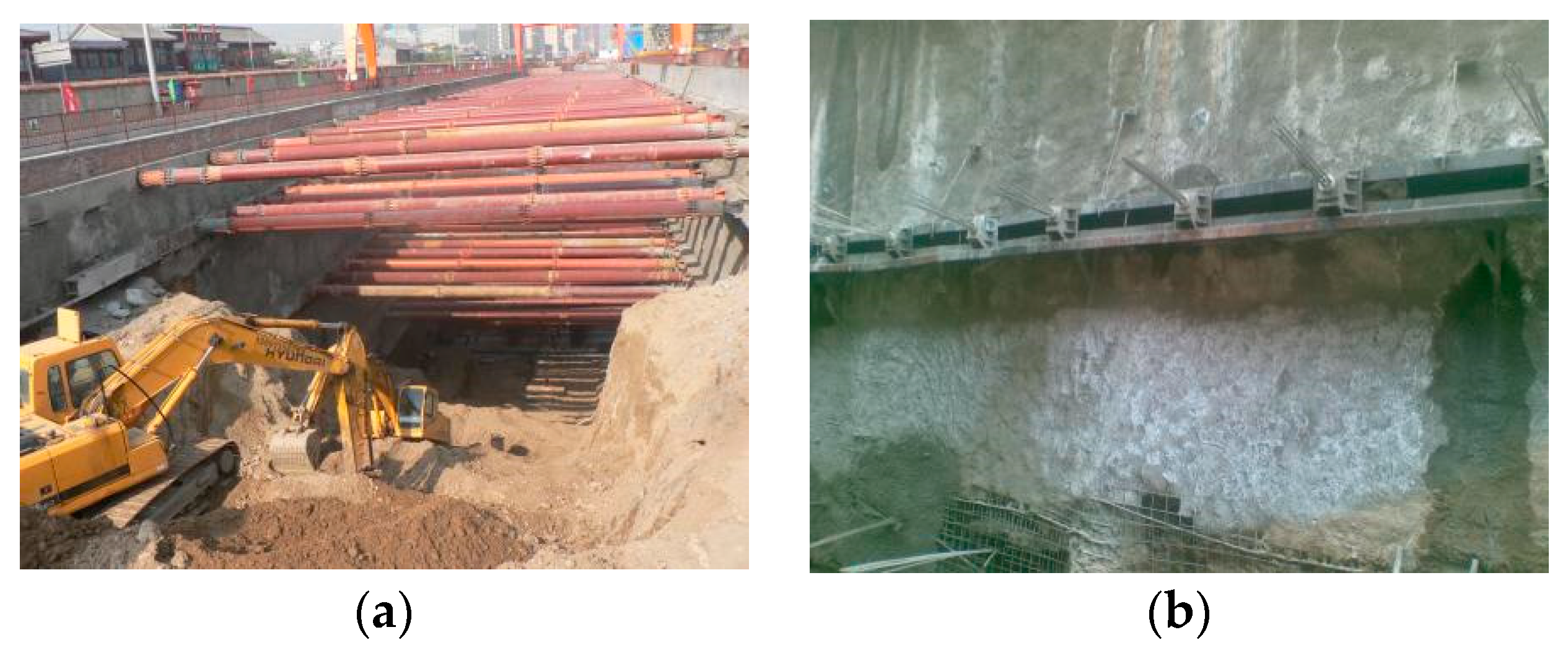

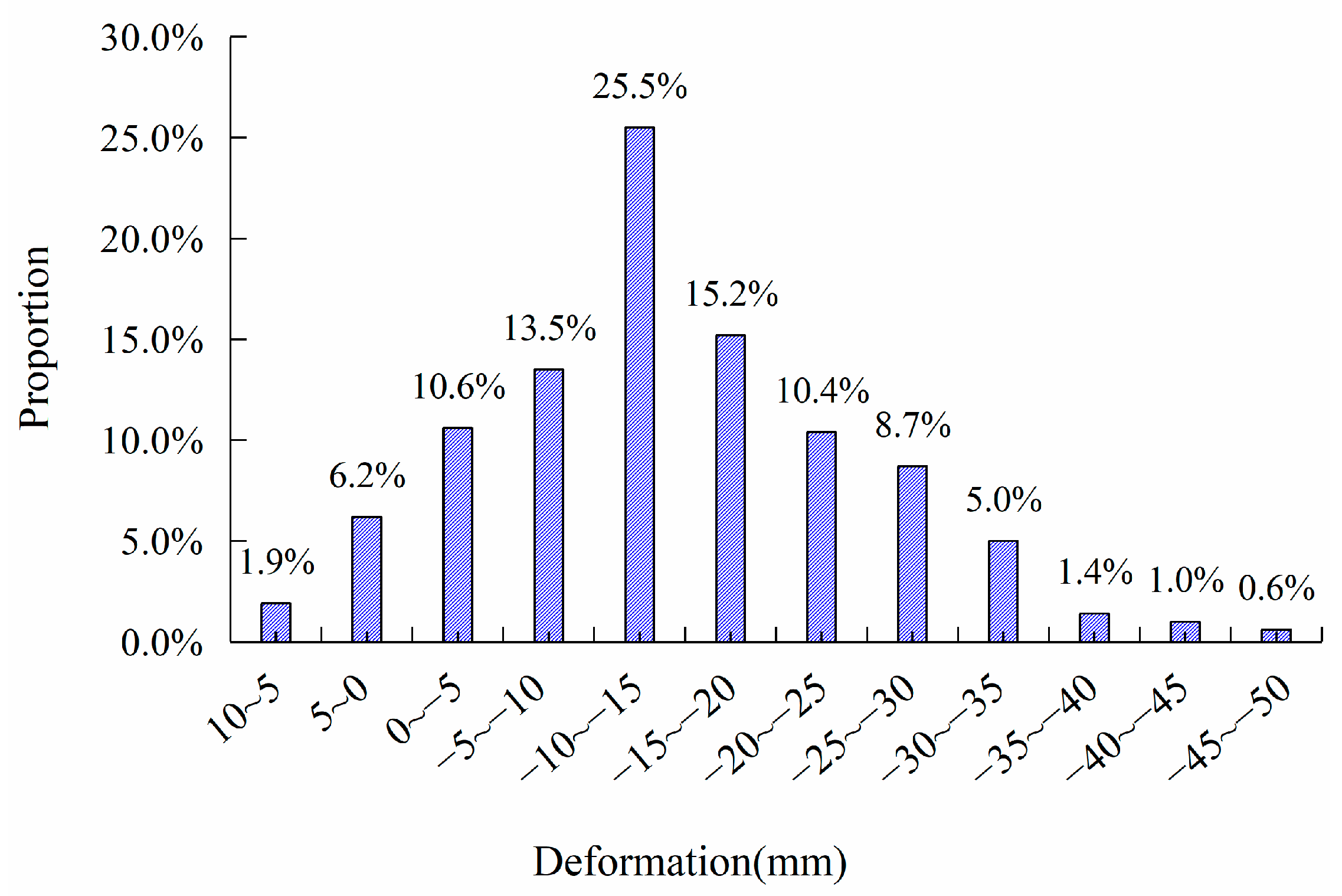
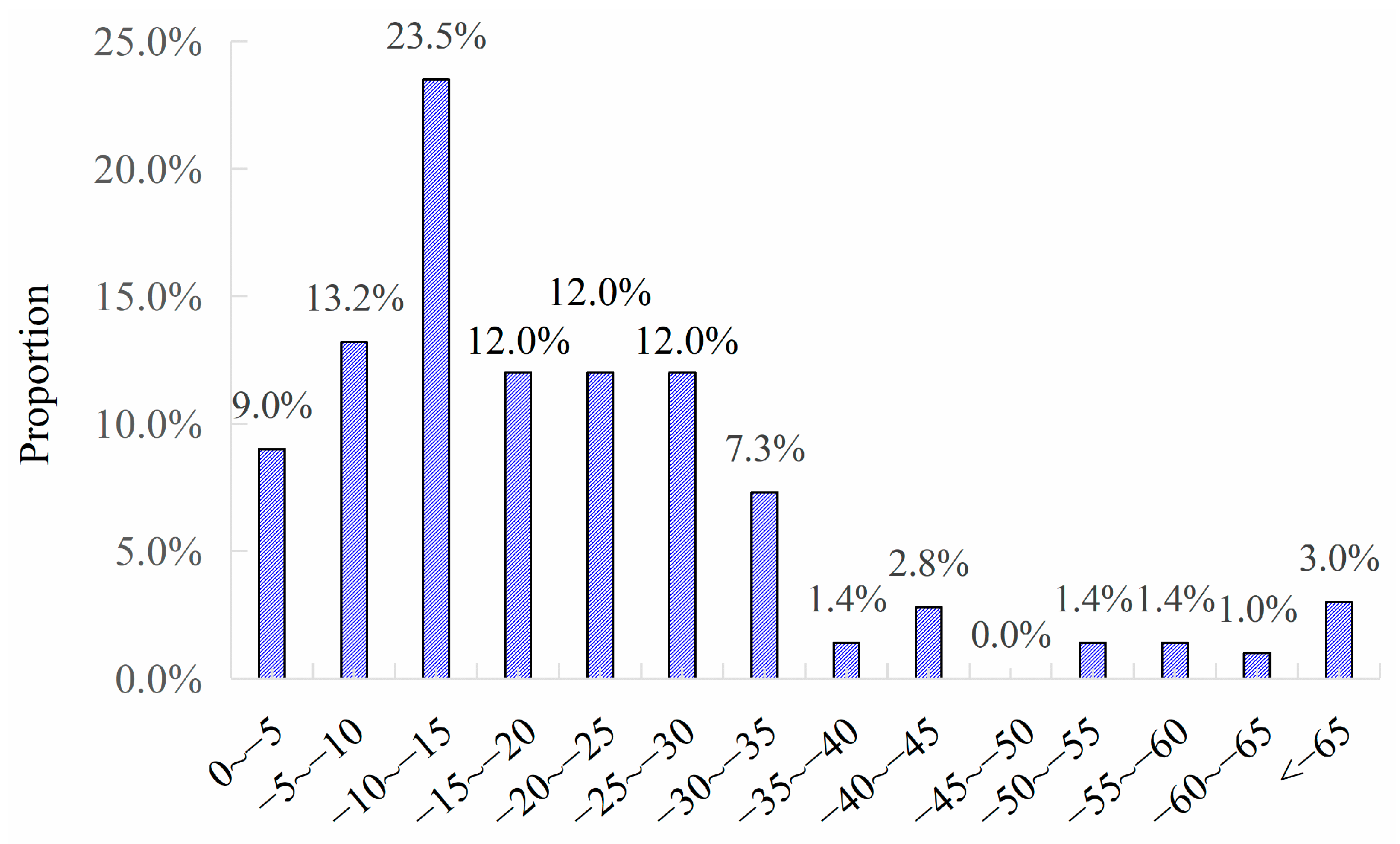
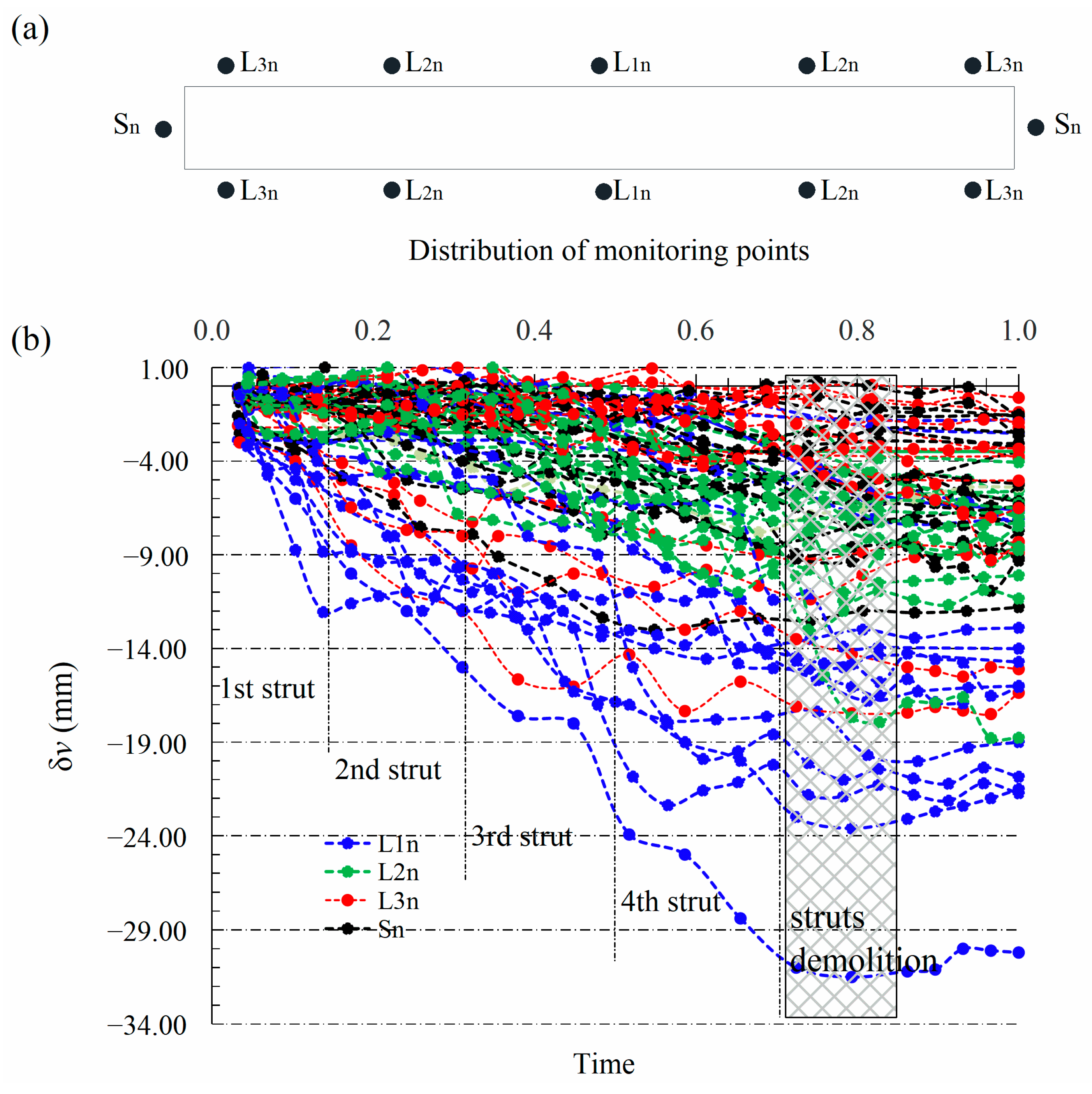
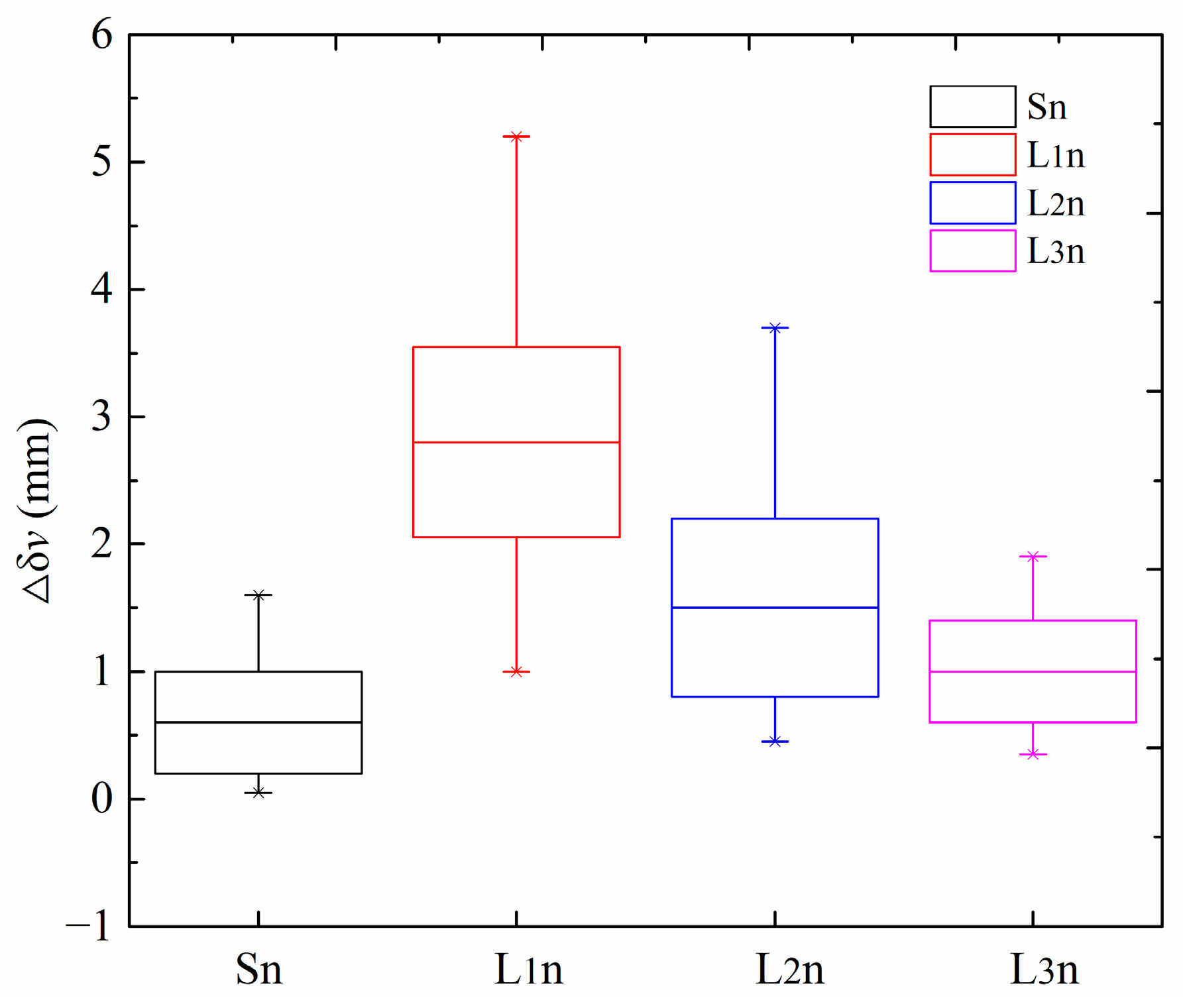

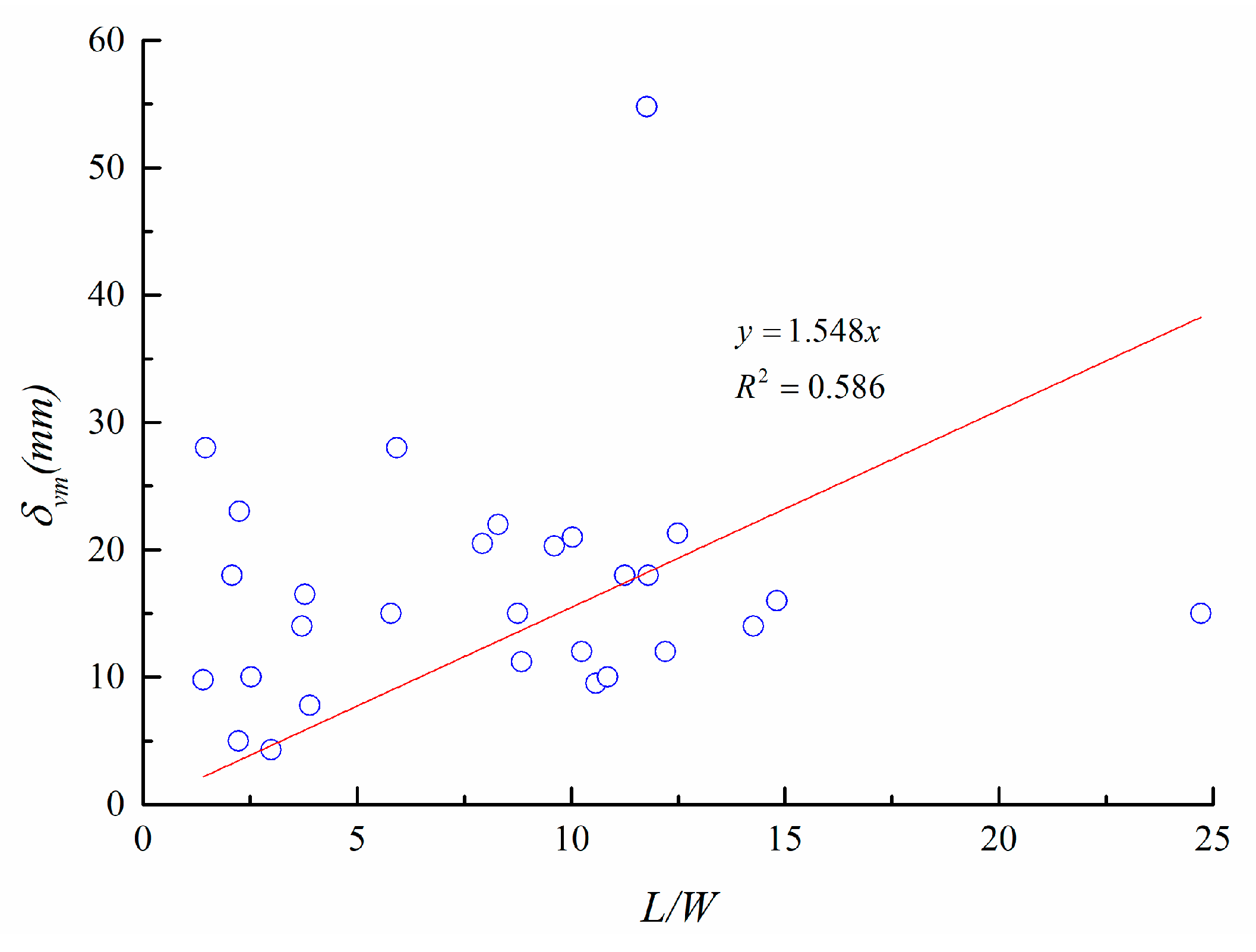

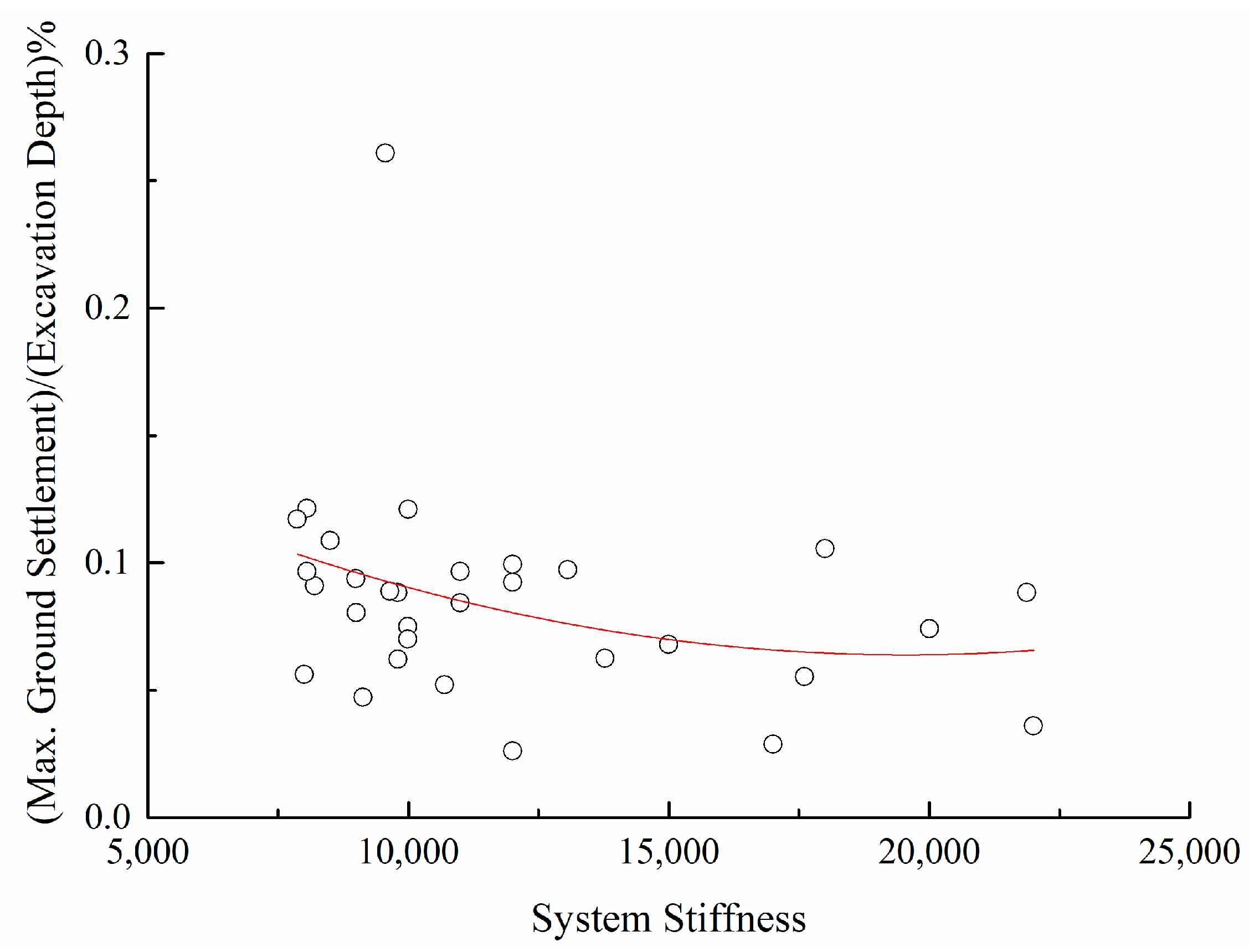
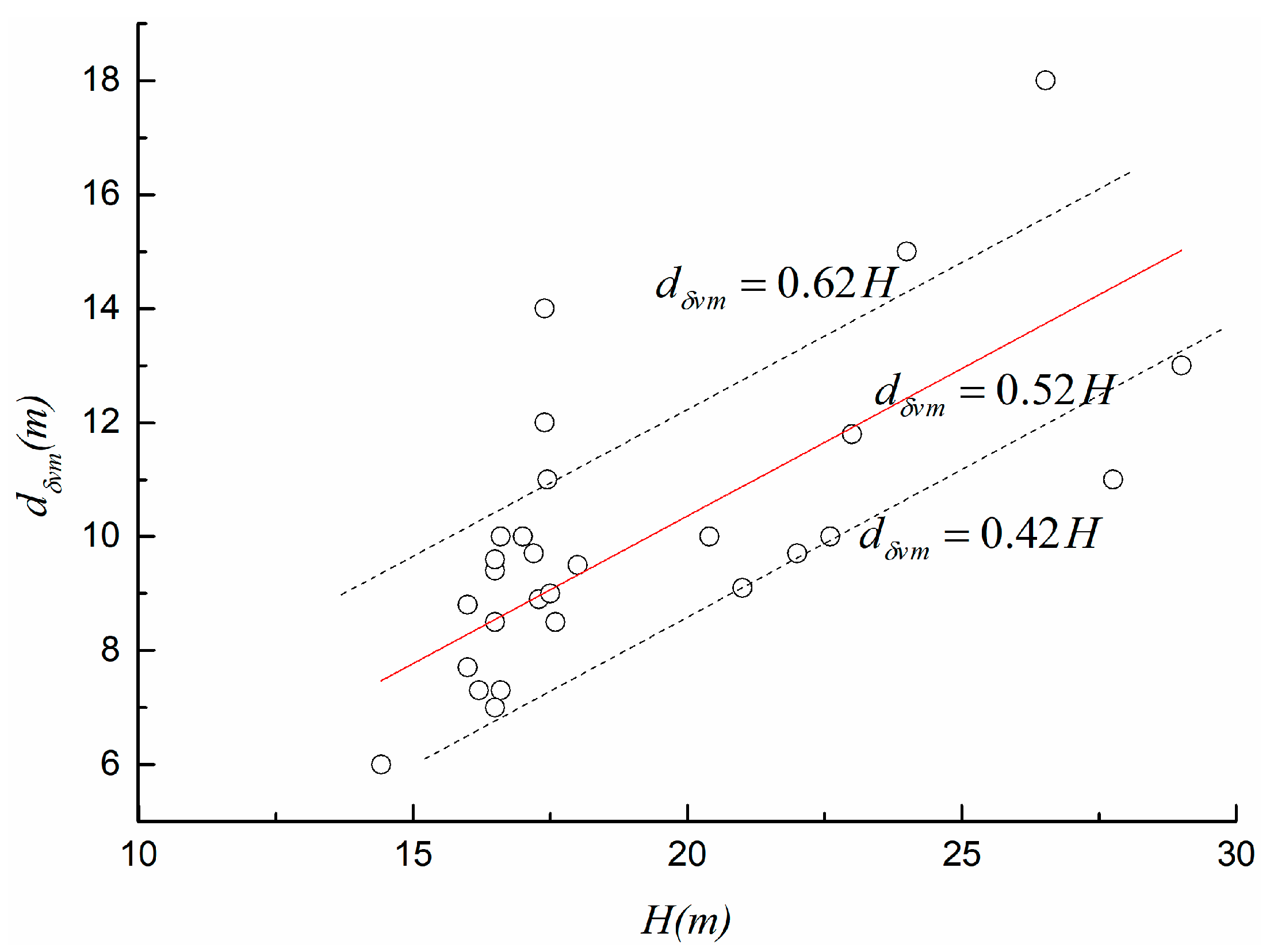
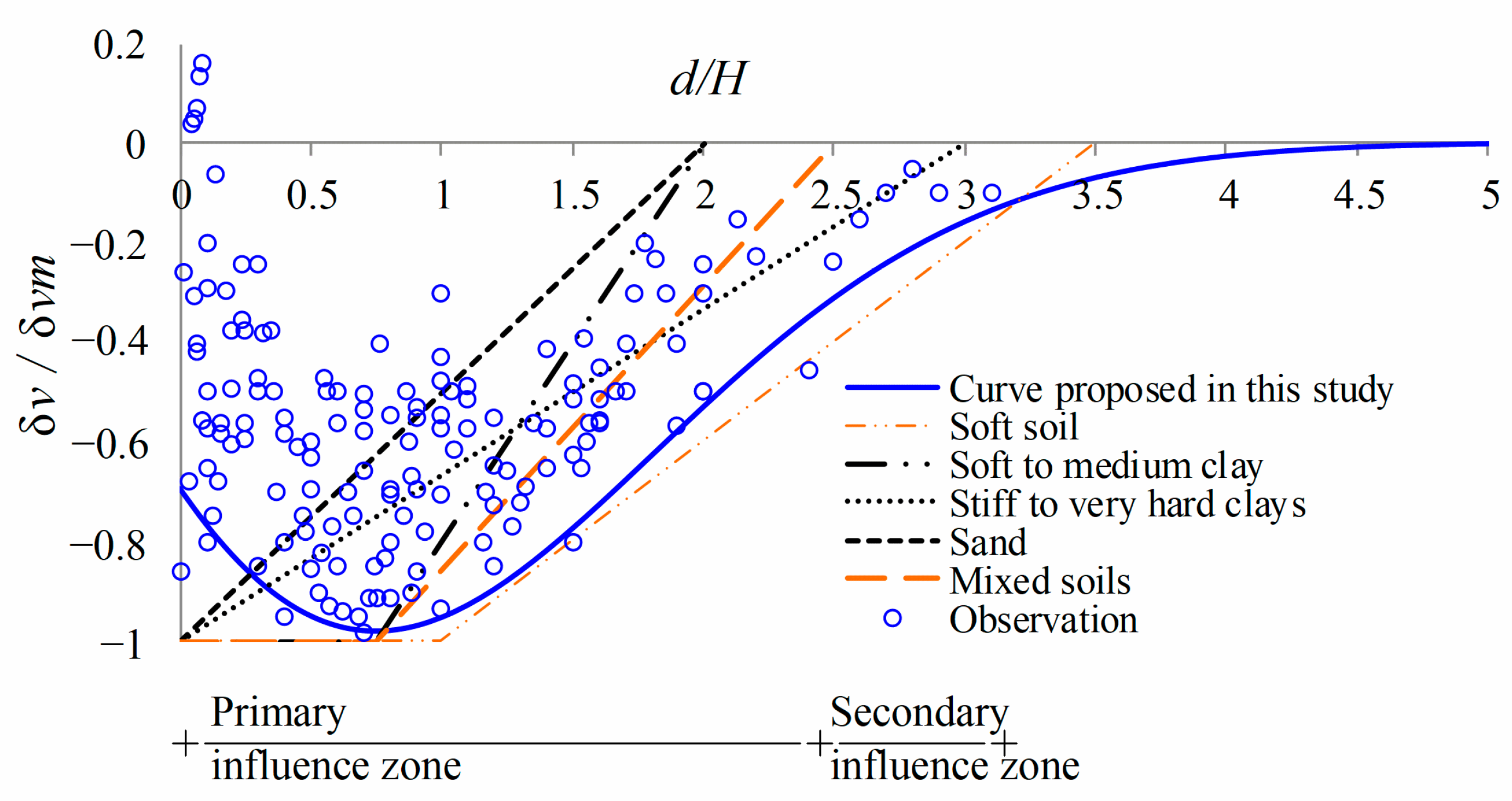
| Soil | Elastic Modulus (MPa) | Poisson’s Ratio (MPa) | Cohesion (kPa) | Friction Angle (°) | Density (g/cm3) |
|---|---|---|---|---|---|
| Backfill soil | 8–15 | 0.382 | 0 | 8 | 1.6 |
| Silt | 13–25 | 0.342 | 14 | 27.5 | 2.03 |
| Silty clay | 9–16 | 0.342 | 33.3 | 14.5 | 1.97 |
| Silty sand | 20–40 | 0.336 | 0 | 32 | 2.0 |
| Gravel | 70–120 | 0.263 | 0 | 38 | 2.15 |
| Sand | 25–45 | 0.336 | 0 | 40 | 2.05 |
| Line No. | Service Time | Mileage /km | Station No. | Open Cut Method | Proportion /% |
|---|---|---|---|---|---|
| 5 | 2007 | 27.6 | 23 | 17 | 73.9 |
| 10 | 2008 | 24.7 | 22 | 9 | 40.9 |
| 4 | 2009 | 28.2 | 24 | 12 | 50.0 |
| 9 | 2011 | 16.5 | 14 | 7 | 50 |
| 7 | 2014 | 23.7 | 20 | 15 | 75 |
| 14 | 2015 | 47.3 | 37 | 21 | 57 |
| 6 | 2021 | 52.9 | 35 | 23 | 66 |
| 8 | 2021 | 51.6 | 35 | 22 | 63 |
| Total | 272.5 | 210 | 126 | 60 |
| Study | Case Number | Ground Condition | Support System | δvm/H (%) | EMR (%) |
|---|---|---|---|---|---|
| Clough, O’Rourke | 22 | Sand, Stiff clay | Multiprop | 0.15 | - |
| Carder | - | UK largely stiffer soil | Multiprop high, moderate, low stiffness | 0.125, 0.2, 0.4 | - |
| Fernie | - | UK stiffer soil | - | 0.15 | - |
| Hashash | 3 | Fill, Clay, Glacial soil | Internal struts | 0.05~0.15 | - |
| Leung | 14 | Hong Kong Mixed soil | Internal strut | 0.02~0.12 | 0.28~1.6, 0.96 |
| Long | 41 | Soft clay < 0.6H Overlay stiff soil | Internal strut, Anchor | 0.12, 0.15 | - |
| Long | 21 | Soft clay > 0.6H Overlay stiff soil | Internal strut, Anchor | 0.5, 0.14 | - |
| Long | 24 | Soft clay > 0.6H | Internal strut, Anchor | 0.8, 0.25 | - |
| Moormann | 512 | Soft clay | Multiprop | 1.07 | - |
| Masuda | 52 | Sand | Multiprop | 0.47 | |
| Clay | 0.44 | ||||
| Ou | 10 | Taipei Soft clay | Internal strut, Anchor | 0.5~0.7 | 0.65 |
| Peck | - | UK soil | Multiprop | 1~2 | |
| Wang, Xu | 300 | Soft clay | Internal struts | 0.42 | 0.45~1.52, 0.88 |
| Wong | - | Soft soil < 0.9H Overlay Decomposed rock | Struts or anchors | 0.5 | - |
| Wong | - | Soft soil < 0.6H Overlay Decomposed rock | Struts or anchors | 0.2 | - |
| This study | 88 | Beijing Mixed soil | Internal Strut, Soil mail, Anchor | 0.089 | - |
Disclaimer/Publisher’s Note: The statements, opinions and data contained in all publications are solely those of the individual author(s) and contributor(s) and not of MDPI and/or the editor(s). MDPI and/or the editor(s) disclaim responsibility for any injury to people or property resulting from any ideas, methods, instructions or products referred to in the content. |
© 2023 by the authors. Licensee MDPI, Basel, Switzerland. This article is an open access article distributed under the terms and conditions of the Creative Commons Attribution (CC BY) license (https://creativecommons.org/licenses/by/4.0/).
Share and Cite
Li, S.; Ge, C.; Li, P.; Yang, M. Ground Deformation Associated with Deep Excavations in Beijing, China. Appl. Sci. 2023, 13, 9579. https://doi.org/10.3390/app13179579
Li S, Ge C, Li P, Yang M. Ground Deformation Associated with Deep Excavations in Beijing, China. Applied Sciences. 2023; 13(17):9579. https://doi.org/10.3390/app13179579
Chicago/Turabian StyleLi, Shu, Chenhe Ge, Pengfei Li, and Meng Yang. 2023. "Ground Deformation Associated with Deep Excavations in Beijing, China" Applied Sciences 13, no. 17: 9579. https://doi.org/10.3390/app13179579






